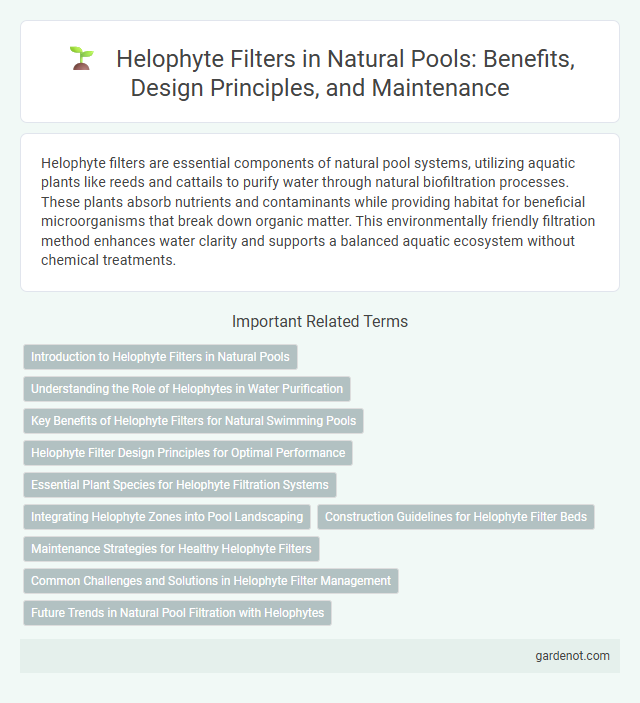Helophyte filters are essential components of natural pool systems, utilizing aquatic plants like reeds and cattails to purify water through natural biofiltration processes. These plants absorb nutrients and contaminants while providing habitat for beneficial microorganisms that break down organic matter. This environmentally friendly filtration method enhances water clarity and supports a balanced aquatic ecosystem without chemical treatments.
Introduction to Helophyte Filters in Natural Pools
Helophyte filters in natural pools use densely planted aquatic vegetation to purify water by trapping sediments and absorbing nutrients. These filters rely on helophytic plants such as reeds and cattails, which create a natural biofilm promoting microbial activity essential for breaking down pollutants. This eco-friendly system enhances water clarity and supports a balanced aquatic ecosystem without chemical treatments.
Understanding the Role of Helophytes in Water Purification
Helophytes play a crucial role in natural pool water purification by absorbing nutrients and trapping suspended particles, which reduces algae growth and maintains water clarity. Their root systems provide a habitat for beneficial microorganisms that break down organic pollutants and convert harmful substances into harmless compounds. This biological filtration process enhances water quality while supporting a balanced aquatic ecosystem without chemical additives.
Key Benefits of Helophyte Filters for Natural Swimming Pools
Helophyte filters enhance water clarity by utilizing rooted aquatic plants to naturally absorb nutrients and filter out impurities, reducing algae growth without chemicals. Their biological filtration process promotes a balanced ecosystem, supporting diverse aquatic life and maintaining water quality. These filters also contribute to sustainable pool maintenance by minimizing energy use and lowering the need for mechanical filtration systems.
Helophyte Filter Design Principles for Optimal Performance
Helophyte filter design principles focus on maximizing water flow through dense root zones of aquatic plants to enhance biological filtration and nutrient uptake. Optimal performance requires careful selection of native helophyte species with high root biomass, ensuring sufficient substrate depth and proper hydraulic retention time to support microbial communities. Integrating layered substrates with gradual slope gradients promotes effective sediment trapping and oxygen diffusion, crucial for maintaining water clarity and ecosystem balance in natural pools.
Essential Plant Species for Helophyte Filtration Systems
Essential plant species for helophyte filtration systems include reeds (Phragmites australis), bulrushes (Schoenoplectus spp.), and cattails (Typha latifolia), which play a critical role in water purification by facilitating nutrient uptake and providing oxygenation. These plants support biofilm development on their root zones, enhancing microbial degradation of pollutants and improving water clarity in natural pools. Selecting native helophytes adapted to local climates ensures system resilience and optimal filtration performance.
Integrating Helophyte Zones into Pool Landscaping
Helophyte filters are essential for maintaining water clarity and ecological balance in natural pools by using aquatic plants that absorb nutrients and pollutants. Integrating helophyte zones into pool landscaping enhances biodiversity, supports natural filtration processes, and creates visually appealing, sustainable aquatic environments. Strategically planted helophyte areas adjacent to swimming zones improve water quality while blending seamlessly with surrounding vegetation.
Construction Guidelines for Helophyte Filter Beds
Helophyte filter beds require precise layering to ensure optimal water purification in natural pools; begin with a gravel base approximately 20-30 cm deep followed by a coarse sand layer and a fine sand surface. Select resilient helophyte plants like Phragmites australis or Typha latifolia, known for their root systems that enhance microbial activity and nutrient absorption. Ensure consistent water flow through the filter bed at a rate of 5-7 liters per square meter per hour to maximize filtration efficiency and prevent stagnation.
Maintenance Strategies for Healthy Helophyte Filters
Helophyte filters require regular removal of accumulated debris and dead plant material to maintain optimal water flow and efficient nutrient uptake. Seasonal pruning of helophytic plants prevents overgrowth, promoting healthy microbial activity essential for effective filtration. Monitoring sediment levels and ensuring proper aeration enhance the biological processes within the filter, sustaining a balanced aquatic ecosystem.
Common Challenges and Solutions in Helophyte Filter Management
Common challenges in helophyte filter management include clogging due to sediment accumulation, uneven plant growth, and fluctuating water levels that affect filtration efficiency. Regular maintenance such as sediment removal, strategic planting for even root distribution, and water level monitoring can optimize filter performance. Implementing a diverse mix of helophyte species enhances resilience against environmental stresses and improves water purification.
Future Trends in Natural Pool Filtration with Helophytes
Future trends in natural pool filtration emphasize enhanced helophyte filter designs that maximize biofiltration efficiency and sustainability. Innovative research explores the integration of diverse plant species with varied root architectures to improve nutrient uptake and pathogen reduction. Advanced monitoring technologies enable precise control of water quality parameters, promoting optimal helophyte growth and long-term ecological balance in natural pools.
Helophyte filter Infographic

 gardenot.com
gardenot.com